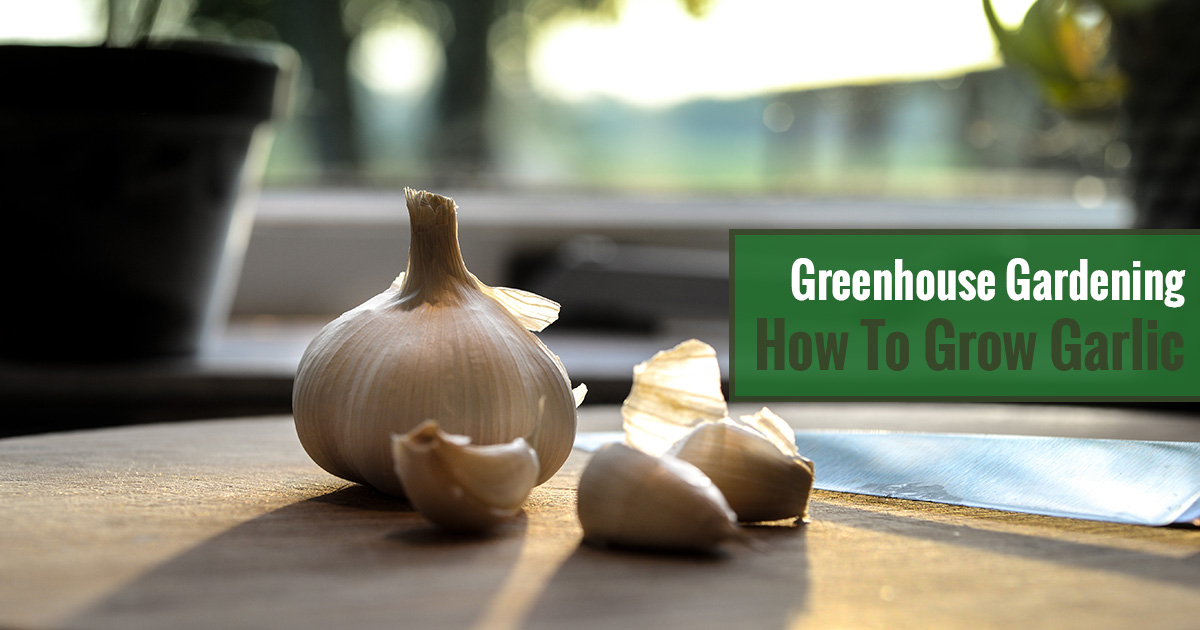
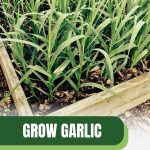
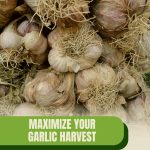

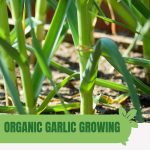
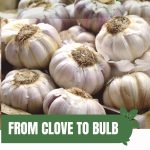

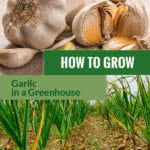
Garlic doesn’t only scare off Dracula! It also scares away pests, so growing garlic in your greenhouse is very useful and it is super easy!
You can grow 10-12 crops from one garlic bulb. It is a very efficient and simple vegetable that thrives perfectly in a greenhouse. Garlic, or Allium sativum, has very few problems and requires little maintenance. Therefore, it’s a great plant for beginners!
For best results, we compiled all our garlic growing tips so that you don’t have to learn it the hard way. To harvest your own greenhouse-grown garlic, learn how to grow garlic in your greenhouse!
Benefits of garlic
Garlic has long been celebrated as a natural superfood and a versatile antibiotic, dating back to ancient civilizations.
One of its key components, allicin, is released when the garlic is crushed or minced. This compound is not only effective in addressing various health issues but also shows promise in fighting severe conditions like cancer and heart disease.
Scientific studies have confirmed garlic’s efficacy in neutralizing a range of harmful bacteria, such as E. coli, Staphylococcus, and Salmonella. Its rich nutrient profile, which includes calcium, Vitamin B6, Vitamin C, copper, selenium, and manganese, further enhances its immune-boosting properties. This makes it a potent defense against common ailments like the flu.
Beyond its health benefits, garlic also serves as a natural insect repellent, effectively warding off a variety of pests like ants, mosquitoes, ticks, and flies. This makes synthetic pesticides almost unnecessary when growing garlic.
As interest in organic and alternative medicine resurges, incorporating garlic into your wellness routine offers a natural way to enhance your health while reducing reliance on synthetic medications.
So why not take the simple steps to grow your own garlic in your greenhouse and reap its myriad benefits?
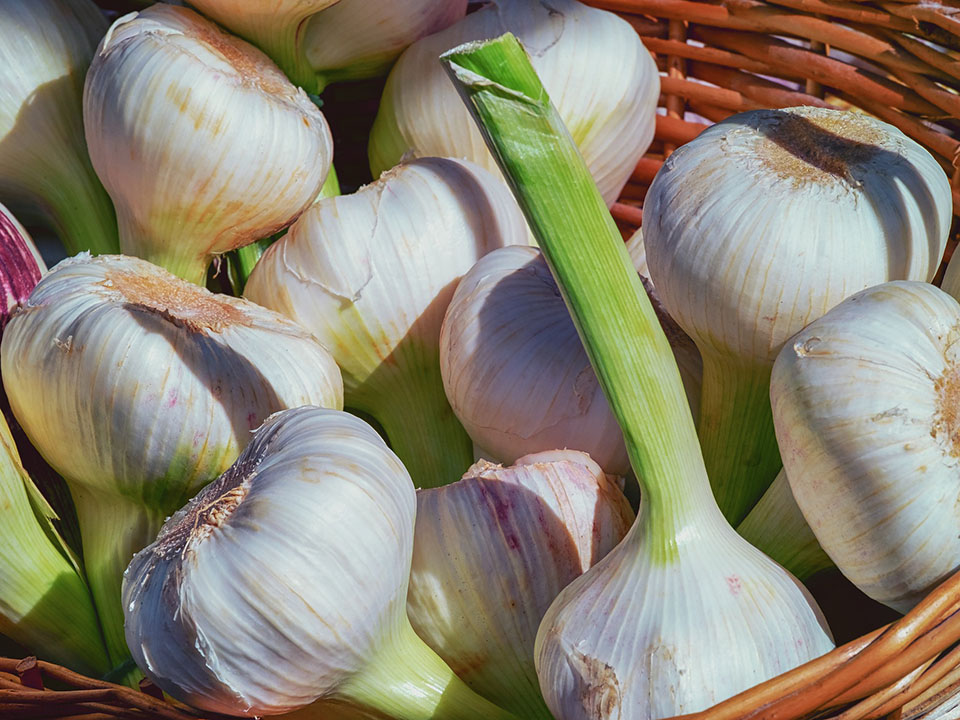
Garlic varieties for greenhouses
Before you start growing garlic in your greenhouse, it’s good to know about the main types of garlic. We are focusing on true varieties of garlic garlic, so we exclude elephant garlic.
Hardneck garlic
Hardneck garlic gets its name from the stiff, woody central stalk, or “neck,” that runs through the middle of the bulb and extends above the ground. This “neck” is also where the garlic scapes, or flower stalks, emerge during the growing season.
Characteristics of hardneck garlic:
- Larger bulbs with fewer, large cloves: Hardneck garlic bulbs typically have fewer cloves compared to softneck varieties. However, these types of garlic usually have larger cloves and are more uniform in size. They are usually arranged in a single layer around the central stalk.
- Climate preference: Hardneck garlic prefers colder winter climates which makes it great for unheated greenhouses.
- Scapes: Hardneck garlic produces curly flower stalks (scapes). They are often cut off to encourage the plant to put more energy into bulb development. However, they are edible so you can use them in cooking dishes.
- Storage: These garlic types generally have a shorter storage life compared to softneck varieties due to their thinner skin.
- Flavor: Many people believe that hardneck garlic has a more robust and complex flavor compared to softneck types.
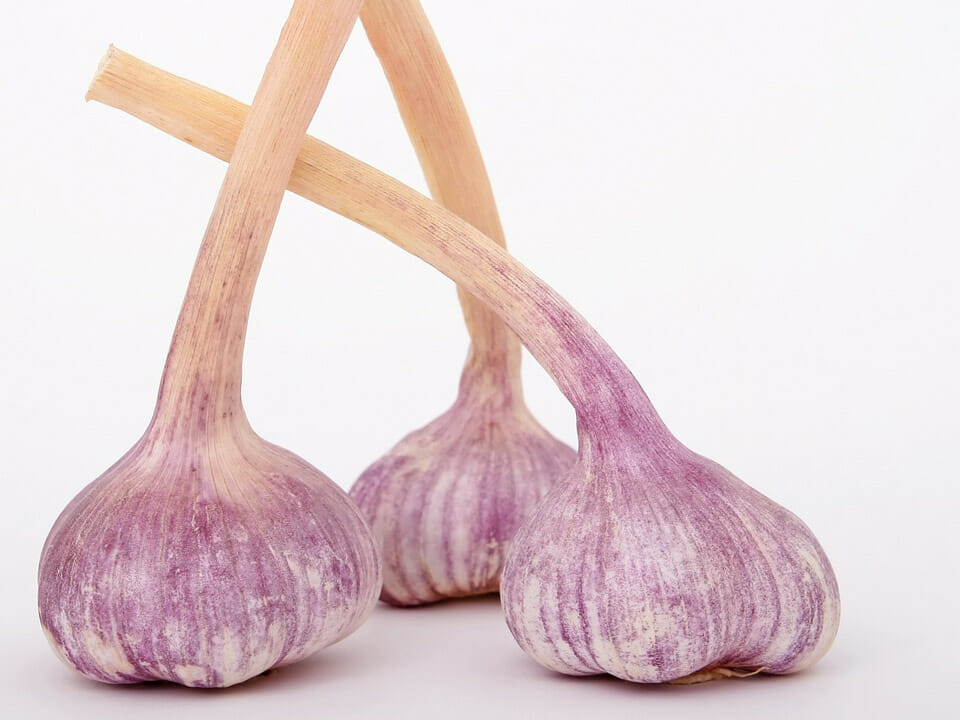
Popular hardneck varieties:
Rocambole: Known for its thin skin and easy peeling. A popular variety is ‘Spanish Roja’.
Purple Striped: Varieties like ‘Starbright’ and ‘Chesnok’ are good for roasting.
Porcelain: Features a plump bulb with only a few fat cloves making the largest bulbs with the largest cloves. Good for storing, with varieties like ‘Georgian Crystal’ and ‘Romanian Red’.
Softneck garlic
Softneck garlic is another primary type of garlic that is commonly sold in grocery stores. Softneck garlic lacks a stiff, woody central stalk, making the neck soft and flexible. This characteristic also makes softneck garlic easier to braid for storage.
Characteristics of softneck garlic:
- More cloves: Softneck garlic bulbs often have more cloves than hardneck varieties. The individual cloves are usually smaller and can be arranged in multiple layers within the bulb.
- Climate adaptability: Softneck varieties are well-suited for warmer climates and are more adaptable to a variety of growing conditions.
- No scapes: Softneck garlic generally does not produce flower stalks, which means all the plant’s energy goes directly into producing a larger bulb.
- Storage: One of the significant advantages of softneck types is their longer storage life. The cloves are covered with multiple layers of papery skin, which helps with preserving the garlic for an extended period.
- Flavor: Softneck garlic is often milder in flavor compared to hardneck varieties, although this can vary.
Popular softneck varieties:
Artichoke: This is the most commonly grown commercial garlic. It has a couple of concentric rows of cloves and is difficult to peel. A well-known variety is ‘Red Toch’.
Silverskins: This type has silvery, white skins and is composed of many small cloves. They also have a sturdy neck that is easily braided. The flavor is usually stronger than Artichokes. Varieties include ‘Nootka Rose’ and ‘Rose du Var’.
Quick overview of growing garlic in a greenhouse
- Type: Cool-season crop, warm-season crop
- Time from clove to harvest: 8-9 months
- Germination temp: 40-50°F
- Time until first emergence: 7-14 days
- Best temp to grow: 50-75°F (can tolerate frost)
- Height: 18-24 in
- Light: Full sun (6-8h)
- Grow from seed: 3-4 in deep (2in deep if mulching), 4-6in apart; rows 18-24in apart
- Companions: Fruit trees, dill, beets, kale, potatoes, carrots, eggplants, tomatoes, broccoli, summer savory, and more
- Keep away from: Beans, asparagus, peas, sage, parsley
Planting garlic cloves in your greenhouse
Growing garlic in your greenhouse allows for year-round cultivation of this versatile plant. By controlling the environment, you can grow varieties that may not thrive outdoors in your region.
It is surprisingly easy to grow garlic in a greenhouse because it is one of the most stress-free crops.
Can you use store-bought garlic bulbs?
We suggest not using garlic from the grocery store because they may not be the suitable varieties for your area and most are treated for extended shelf life, meaning they take considerably longer to set root.
It would be better if you could get your hands on organic garlic (maybe from a farmers market), from a neighbor, or buy the seed bulbs from a store.
4 simple steps to grow garlic from cloves:
- Divide the garlic cloves from a fresh bulb: Be mindful not to break the cloves at their center, where they join at the base. If the base is destroyed, it will not develop. You also want to use a healthy bulb. Make sure each clove keeps its papery husk.
- Push every garlic clove 3-4 inches into the soil (or 2 inches if you’ll use mulch): Direct the pointed tip upward and the root side downward. Keep about 4-6 inches between the cloves and if planted in rows, keep 18 inches of distance.
- Cover the planted garlic cloves with mulch: Lay an organic mulch such as straw. This helps to nourish plants while keeping the soil cool and moist.
- Side-dress the garlic cloves or fertilize with compost: Fertilize repeatedly just before the bulbs start to swell or if you detect yellowing leaves.
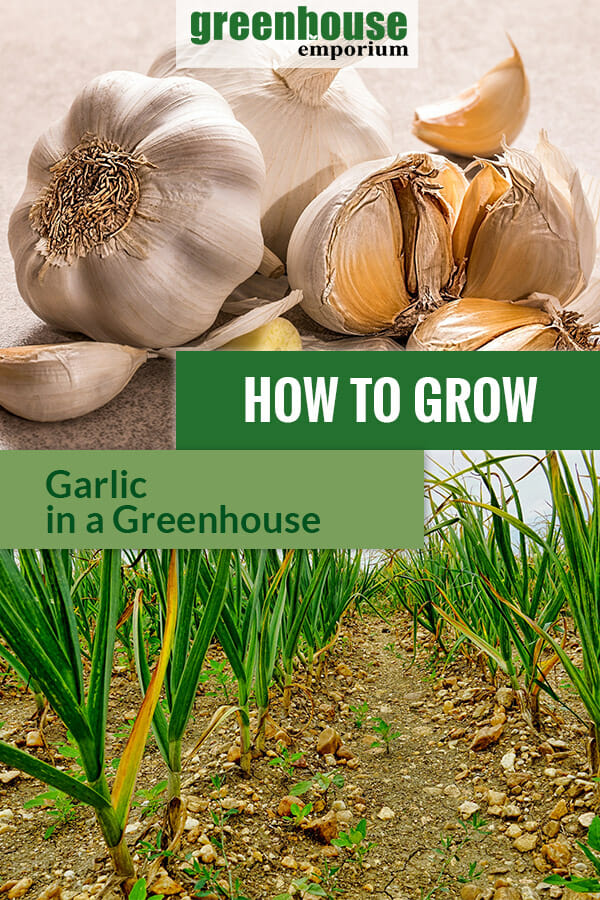
Tips & tricks for growing garlic in a greenhouse
Plant the larger garlic cloves: The smaller cloves take up just as much space as the bigger pieces in the garden bed, but they harvest much smaller bulbs.
If you intend on planting garlic once more after harvesting, collect some of your biggest, best-formed garlic heads. This way you’ll have a never-ending supply.
The answer to producing excellent returns is to make certain to plant your garlic in a spot where it will get lots of sunlight regularly.
Garlic generally grows well on clear grounds without weeds so tilling the ground just before planting is essential unless you choose planters or raised beds.
Separate the garlic cloves just before planting, preferably within 24 hours so the root nodules do not dry. This helps the cloves to set root quickly.
When garlic begins to flower, cut off the shoots because it will result in large bulbs. Flowering directs the energy into the flower and not the bulb.
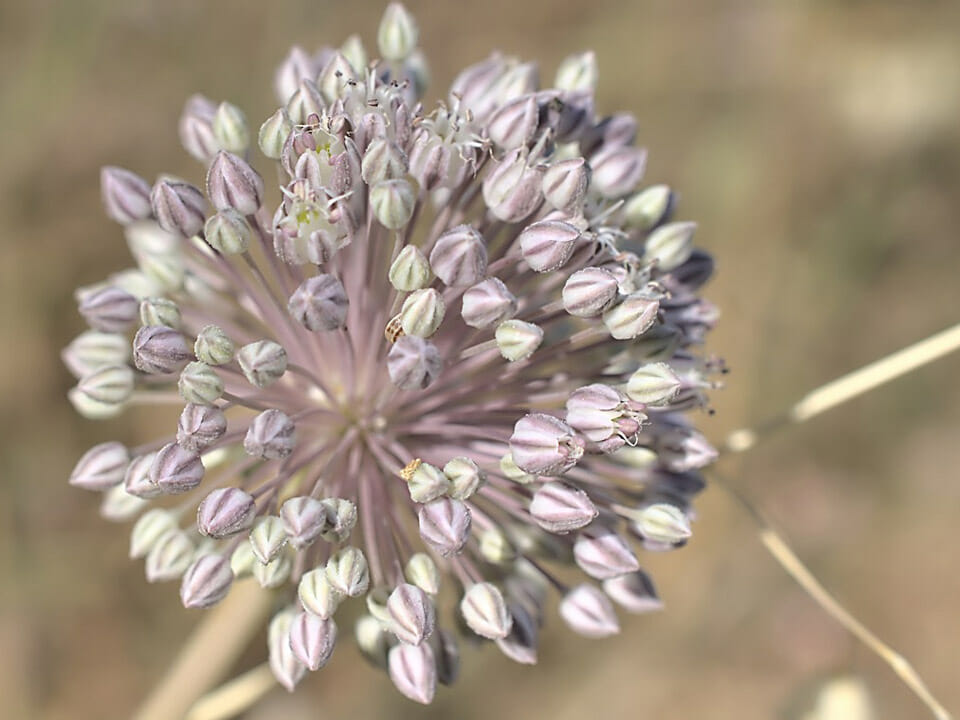
Watering requirements
Simply water the soil if it is dry (around 2-4 inches every four days). Never pour water over the crowns. Decrease irrigating when it stops producing fresh leaves and starts to develop bulbs.
Soil requirements
The preferred soil temperature is between 40 and 50°F until the roots have developed. Then it does well with colder temperatures (dormancy period). Outdoors garlic is usually planted a few weeks before the first frost. This allows the garlic plants to mature before the ground freezes. In a greenhouse, you may run a heater so you don’t need to worry about this.
Garlic prefers sandy clay loam with plenty of organic matter (pH level of 6.5 to 7.0) and it should be well-drained soil.
Keep the soil free of weeds. Fertilize the garlic plants with compost or fertilizer with a 1-2-2 NPK ratio. Side-dress plants when leaves start yellowing or when they are 8 inches tall. Don’t fertilize within the last few months before harvest (usually not after later spring when grown outdoors).
Lighting requirements
Garlic requires plenty of direct sunlight. Before planting, ensure the spot will provide adequate light. Don’t plant it on the lowest level in case you’re using shelves.
Common garlic problems
Garlic does not grow well with competition so make sure you weed the area. Prevent pests and diseases by practicing crop rotation (at a minimum every 2 years).
Garlic plants usually don’t have many problems with pests. Bulb mites may be a problem. They are feeding on the bulbs and live within the skins of cloves. These creatures are very tiny and hard to see. Twisted leaves and stunted growth are signs of this pest.
Birds can sometimes be a problem. They can destroy the seedlings, garlic shoots, and leaves. However, this shouldn’t be a problem in your greenhouse.
If you don’t have well-draining soil, you may experience rotting bulbs. White rot is a fungus that can strike garlic in a cold climate. It upsets the bottom of the roots and leaves. It can be solved by rotating crops as well.

When to harvest garlic from your greenhouse
The sign for harvesting is yellowing leaves. However, you don’t want to wait until all leaves are dry. The bulbs are ripe when most of the low-hanging leaves are brown and 6-7 leaves remain green.
Loosen the soil and then lift the garlic bulbs out. Remember that reckless reaping can injure a quality crop of garlic. You may need a fork or scoop to lift the bulb from the soil.
Once you’ve harvested your garlic, let it dry in a dim area with plenty of airflow for 2-3 weeks. Then cut off the roots and tops (about an inch above the bulb) or braid it for hanging storage.
FAQs about growing garlic in a greenhouse
How long does garlic take to grow in a greenhouse?
Garlic grows quickly once planted but takes a while to reach harvest. Some varieties mature faster than others. Most don’t reach maturity until 6-9 months of growth.
Can you dry garlic in a greenhouse?
You can dry garlic in your greenhouse. Find a dry place that allows for air circulation and is a bit dim. The drying process takes about 2-3 weeks, depending on temperatures and humidity. To properly dry garlic, it is important to hang it or spread it out on a sheet with good air circulation. Failing to do this can result in slow drying and mold growth which will ruin the garlic.
What are good companion plants for garlic?
Garlic is a potent plant and care should be taken in choosing companions to grow alongside it. Some plants benefit from garlic, while others will have their growth stunted. Plants that will thrive next to garlic include fruit trees, dill, beets, kale, potatoes, carrots, eggplants, tomatoes, broccoli, summer savory, rue, chamomile, yarrow, spinach, peppers, cabbage, cauliflower, kohlrabi, roses, geraniums, marigolds, nasturtiums.

